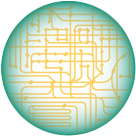Biological Imaging of Plant and Fungal Samples Using Infrared Light
Authors:
Demosthenes Morales1* ([email protected]), Kati Seitz2, Duncan Ryan1, David Hanson2, and James Werner1
Institutions:
1Los Alamos National Laboratory and 2University of New Mexico
Goals
The team aims to measure water, lignocellulose, and lipid content in plants using a quantum ghost imaging microscope that exploits entangled photon pairs. In this approach, one photon from the entangled photon pair passes through the sample and is detected by a single element detector, while the other is detected by an imaging sensor. The microscope probes a sample at the near- or mid-infrared (where a molecular vibrational fingerprint is detectable) and images in the visible where efficient low-noise imaging detectors are available. Entangled photon pairs are generated one pair at a time by spontaneous parametric down conversion and by detecting the photons simultaneously the noise of the system is greatly reduced by direct counting of coincidences of photons correlated in detector arrival time. This system generates high signal-to-noise ghost images with an illumination less than starlight, providing extended monitoring over time with little to no perturbation to the biological sample.
Abstract
The team demonstrates the utility of infrared spectroscopy on environmental and plant samples as a complementary method to identifying key molecular features for biological monitoring using quantum ghost imaging microscopy. For this project, team members characterized two plant models (poplar and sorghum) and a species of fungus to assess the features obtained by infrared light on samples broadly relevant to the DOE BER research portfolio. Researchers perform conventional Fourier transform infrared spectroscopy to obtain infrared spectra of chemical features such as lignocellulose, proteins, and lipids in samples to generate a database relevant to sample biomass. This database is then analyzed by principal component analysis to determine the spectral basis for which they can be separated according to phenotypic differences. By identifying the features that are most divergent between samples, researchers can assess the major biological shifts being observed at probe wavelengths during long-term monitoring by quantum ghost imaging.
Funding Information
This work was supported by the U.S. Department of Energy, Office of Science, Biological and Environmental Research Division, under award number 0000253585.
